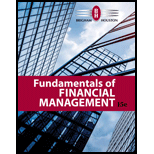
Concept explainers
a.
To determine: Theaverage expected inflation rate.
Expected Inflation Rate:
The expected inflation rate is the rate at which the price is expected to increase over the time, which results in fall of the purchasing value.
Nominal Rate of Interest:
The nominal rate of interest is the annual rate which is charged on the securities. The nominal annual rate is converted into effective annual rate to compare the rates of two different banks.
b.
To determine: The average nominal interest rate.
c.
To determine: The interest rate in January 1981 on the bonds that has its maturity in 1,2, 5, 10 and 20 years and draw a yield curve on these data.
d.
To explain: The general economic conditions that can lead to an upward sloping yield curve.
e.
To determine: The shape of the yield curve in the given situation and the factors affecting the curve.
Trending nowThis is a popular solution!

Chapter 6 Solutions
Bundle: Fundamentals Of Financial Management, 15th + Mindtap Finance, 2 Terms (12 Months) Printed Access Card
- 3 years ago, you invested $9,200. In 3 years, you expect to have $14,167. If you expect to earn the same annual return after 3 years from today as the annual return implied from the past and expected values given in the problem, then in how many years from today do you expect to have $28,798?arrow_forwardPlease Don't use Ai solutionarrow_forwardEnds Feb 2 Discuss and explain in detail the "Purpose of Financial Analysis" as well as the two main way we use Financial Ratios to do this.arrow_forward
- Nikes annual balance sheet and income statement for 2022-2023 and 2024arrow_forwardWhat is the value at the end of year 3 of a perpetual stream of $70,000 semi-annual payments that begins at the end of year 7? The APR is 12% compounded quarterly.arrow_forwardFirm A must pay $258,000 to firm B in 10 years. The discount rate is 16.44 percent per year. What is the present value of the cash flow associated with this arrangement for firm A? -I got the answer of 56331.87773=56332 (rounded to the nearest dollar), but it says incorrect.arrow_forward
 EBK CONTEMPORARY FINANCIAL MANAGEMENTFinanceISBN:9781337514835Author:MOYERPublisher:CENGAGE LEARNING - CONSIGNMENT
EBK CONTEMPORARY FINANCIAL MANAGEMENTFinanceISBN:9781337514835Author:MOYERPublisher:CENGAGE LEARNING - CONSIGNMENT

